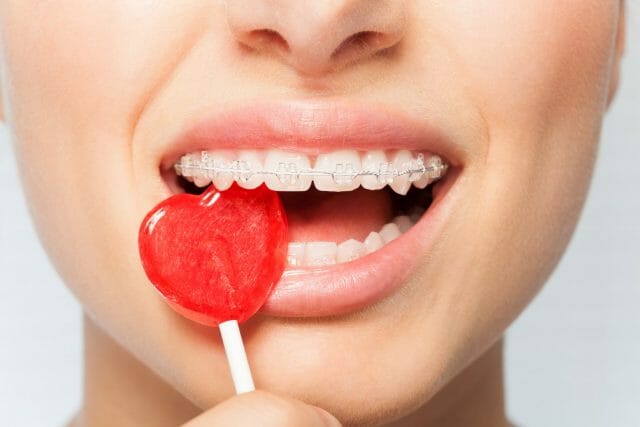
Getting braces is a significant step towards achieving a beautiful, healthy smile. However, it does come with certain lifestyle adjustments, especially concerning your diet.
In this guide, we’ll explore what you can and can’t eat with braces, ensuring you stay on track without sacrificing delicious meals.
How Braces Works?
Braces work by applying continuous pressure to your teeth over time, gradually shifting them into the desired position. This process involves brackets, wires, and sometimes rubber bands, all working together to correct your dental alignment.
Because of their design, braces can be delicate and require careful maintenance, particularly when it comes to what you eat.
Why Diet Matters When You Have Braces
Your diet plays a crucial role in the success of your orthodontic treatment. Eating the wrong foods can damage your braces, prolong your treatment time, and even cause oral health issues. Understanding what foods to enjoy and what to avoid is essential for a smooth and effective treatment journey.

What You Can Eat with Braces
Soft Foods for Braces
- Dairy products – Dairy products are fantastic for those with braces. Yogurt, soft cheeses, and milkshakes provide the necessary nutrients without risking damage to your braces. They are easy to consume and gentle on your teeth.
- Grains and Bread – Soft grains and bread are another excellent option. Opt for pasta, rice, and soft tortillas. Soft bread, muffins, and pancakes are also great choices that won’t harm your braces.
- Fruits and Vegetables – While some fruits and vegetables might need to be avoided, many are perfectly safe. Soft fruits like bananas, berries, and melons are braces-friendly. Vegetables like steamed broccoli, carrots, and mashed potatoes are also excellent choices.
- Meats and Proteins – Tender meats like chicken, turkey, and fish are ideal. Ensure they are cut into small pieces to avoid any issues. Eggs, tofu, and beans are also great protein sources that are safe for braces.
Healthy Snacks That Are Braces-Friendly
When snacking, you’ll need to be selective to avoid damaging your braces. Safe options include smoothies, applesauce, soft fruits, and cheese slices. Yogurt and pudding cups are also convenient and braces-friendly.
Meal Ideas for Breakfast, Lunch, and Dinner
- Breakfast – Consider options like scrambled eggs, yogurt with soft fruits, or oatmeal. Smoothies packed with fruits and a touch of honey can also be a nutritious start to your day.
- Lunch – Soft sandwiches with deli meat, cheese, and a bit of mustard or mayo are great. Avoid hard bread and stick with soft, fresh slices. A side of steamed vegetables or a soft fruit salad makes for a balanced meal.
- Dinner – For dinner, think about soft proteins and grains. Baked fish, tender chicken, or a tofu stir-fry paired with rice or mashed potatoes are ideal. Steamed veggies or a soft pasta dish can round out the meal.

What You Can’t Eat with Braces
Hard and Crunchy Foods
Avoiding hard and crunchy foods is essential to prevent breaking your braces. This includes nuts, popcorn, chips, and hard candies. These foods can snap wires or dislodge brackets, leading to emergency visits to the orthodontist.
Sticky and Chewy Foods
Sticky and chewy foods like caramel, gummy candies, and chewing gum are big no-nos. These can get stuck in your braces and are incredibly difficult to clean out, increasing the risk of cavities and other dental problems.
Sugary Foods and Drinks
Sugary foods and drinks can cause significant issues for anyone, but they’re especially problematic for those with braces. Sugary sodas, juices, and candies can lead to tooth decay and white spots on your teeth. It’s best to limit these as much as possible.
Navigating Special Occasions and Dining Out
Choosing Braces-Friendly Options at Restaurants
Dining out with braces doesn’t have to be a challenge. Opt for dishes that are soft and easy to chew. Think about soups, stews, pasta dishes, and steamed vegetables. Avoid anything that comes with hard, crusty bread or tough meats.
Celebrating Holidays and Parties with Braces
Holidays and parties often feature a lot of foods that aren’t braces-friendly. Focus on enjoying soft options like mashed potatoes, soft casseroles, and tender meats. If there are sweets, look for softer desserts like pudding or ice cream instead of cookies or brittle candies.
Tips for Eating with Braces
How to Cut and Prepare Foods
Cutting your food into smaller pieces can make it easier to eat without damaging your braces. For fruits and vegetables, slicing them into bite-sized chunks helps prevent any hard bites that could cause problems.
Eating Out and Social Situations
In social situations, it’s okay to be selective about what you eat. Don’t be shy about asking how a dish is prepared or requesting modifications. Most people understand and will accommodate your needs.
Handling Discomfort and Pain After Adjustments
After getting your braces adjusted, your teeth and gums might feel sore. During these times, stick to very soft foods like soups, mashed potatoes, and smoothies. Over-the-counter pain relief can also help manage discomfort.
Common Questions About Eating with Braces
Can You Chew Chewing Gum with Braces?
No, it’s best to avoid chewing gum with braces. The sticky nature of gum can get tangled in your brackets and wires, causing damage and making it difficult to clean your teeth properly.
What to Do If You Accidentally Eat Something You Shouldn’t
If you accidentally eat something you shouldn’t and damage your braces, contact your orthodontist as soon as possible. They can guide you on the next steps and schedule a repair appointment if needed.
Conclusion
Maintaining a Healthy Diet with Braces
Maintaining a healthy diet with braces is entirely possible with some planning and knowledge. Stick to soft, braces-friendly foods and be mindful of the types of snacks and meals you choose.
The Importance of Oral Hygiene
Oral hygiene is more critical than ever with braces. Brush and floss regularly, and use special orthodontic tools like interdental brushes to keep your teeth and braces clean.
Final Thoughts
Eating with braces may require some adjustments, but it’s entirely manageable. By understanding what you can and can’t eat, you can keep your braces in good condition and ensure your treatment progresses smoothly. Remember, the effort is worth it for the beautiful smile you’ll have at the end!
FAQs
1. How long will I need to avoid certain foods with braces?
You’ll need to avoid certain foods for the entire duration of your braces treatment, which typically lasts between 18 months to 2 years.
2. Can I drink soda with braces?
It’s best to limit soda intake as it is high in sugar and can contribute to tooth decay and damage to your braces.
3. Are there any special utensils I should use with braces?
While you don’t need special utensils, using a knife to cut food into smaller pieces can be helpful.
4. How do I clean my braces after eating?
Brush your teeth after every meal using a soft-bristled toothbrush and fluoride toothpaste. Floss at least once a day and consider using an interdental brush for better cleaning around your braces.
5. What should I do if a bracket or wire breaks while eating?
If a bracket or wire breaks, contact your orthodontist immediately for advice and to schedule a repair. In the meantime, orthodontic wax can help protect your mouth from any sharp edges.


